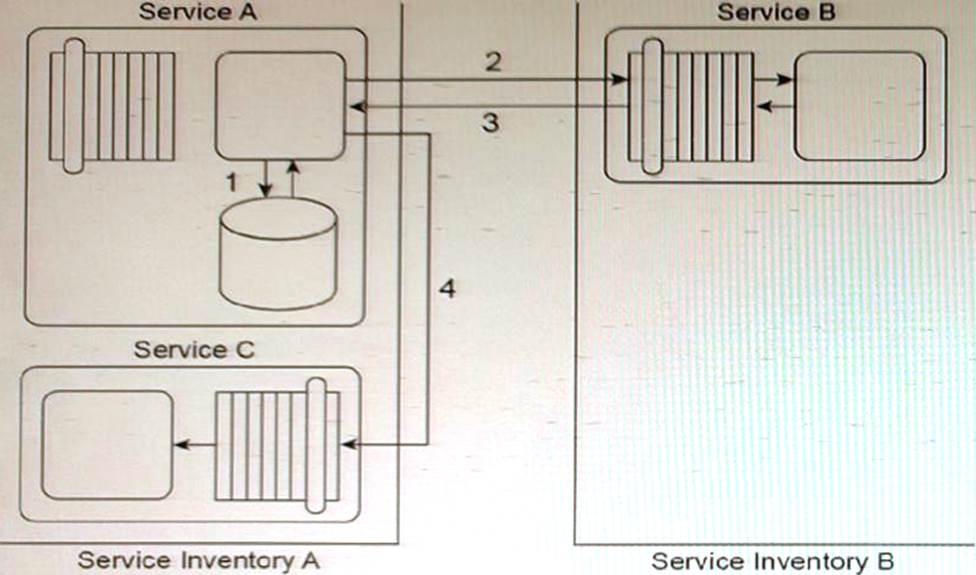What steps can be taken to solve these problems?
Service A is a task service that sends Service B a message (2) requesting that Service B return data back to Service A in a response message (3). Depending on the response received, Service A may be required to send a message to Service C (4) for which it requires no response.

Before it contacts Service B, Service A must first retrieve a list of code values from its own database (1) and then place this data into its own memory. If it turns out that it must send a message to Service C, then Service A must combine the data it receives from Service B with the data from the code value list in order to create the message it sends to Service C. If Service A is not required to invoke Service C, it can complete its task by discarding the code values.
Service A and Service C reside in Service Inventory A. Service B resides in Service Inventory B.
You are told that the services in Service Inventory A were designed with service contracts that are based on different design standards and technologies than the services In Service Inventory B. As a result, Service A is a SOAP-based Web service and Service B Is a REST service that exchanges JSON-formatted messages. Therefore, Service A and Service B cannot currently communicate. Furthermore, Service C is an agnostic service that is heavily accessed by many concurrent service consumers. Service C frequently reaches its usage thresholds, during which it is not available and messages sent to it are not received.
What steps can be taken to solve these problems?
A. The Data Model Transformation pattern can be applied by establishing an intermediate processing layer between Service A and Service B that can transform a message from one data model to another at runtime. The Intermediate Routing and Service Agent patterns can be applied so that when Service B sends a response message, a service agent can intercept the message and, based on its contents, either forward the message to Service A or route the message to Service C. The Service Autonomy principle can be further applied to Service C together with the Redundant Implementation pattern to help establish a more reliable and scalable service architecture.
B. The Data Format Transformation pattern can be applied by establishing an intermediate processing layer between Service A and Service B that can transform a message from one data format to another at runtime. The Asynchronous Queuing pattern can be applied to establish an intermediate queue between Service A and Service C so that when Service A needs to send a message to Service C, the queue will store the message and retransmit it to Service C until it is successfully delivered. The Service Autonomy principle can be further applied to Service C together with the Redundant Implementation pattern to help establish a more reliable and scalable service architecture.
C. The Data Model Transformation pattern can be applied by establishing an intermediate processing layer between Service A and Service B that can transform a message from one data model to another at runtime. The Intermediate Routing and Service Agent patterns can be applied so that when Service B sends a response message, a service agent can intercept the message and, based on its contents, either forward the message to Service A or route the message to Service C. The Service Statelessness principle can be applied with the help of the State Repository pattern so that Service A can write the code value data to a state database while it is waiting for Service B to respond.
D. The Data Format Transformation pattern can be applied by establishing an intermediate processing layer between Service A and Service B that can transform a message from one data format to another at runtime. The Asynchronous Queuing pattern can be applied to establish an intermediate queue between Service A and Service B so that when Service A needs to send a message to Service B, the queue will store the message and retransmit it to Service B until it is successfully delivered. The Service Reusability principle can be further applied to Service C together with the Redundant Implementation pattern to help establish a more reusable and scalable service architecture.
Answer: B
Explanation:
The problem is that Service A and Service B are using different technologies and cannot communicate. Therefore, an intermediate processing layer can be established that can transform messages from one data format to another at runtime. This can be achieved using the Data Format Transformation pattern.
Additionally, Service C frequently reaches its usage thresholds and is not always available, so an Asynchronous Queuing pattern can be applied to establish an intermediate queue between Service A and Service C. This queue will store the messages sent by Service A to Service C and retransmit them until they are successfully delivered. This approach improves the reliability of the system.
Moreover, the Redundant Implementation pattern can be applied to Service C to ensure its availability and scalability, and the Service Autonomy principle can be applied to make Service C independent of other services.
Latest S90.08B Dumps Valid Version with 17 Q&As
Latest And Valid Q&A | Instant Download | Once Fail, Full Refund

